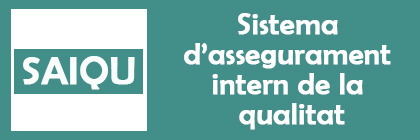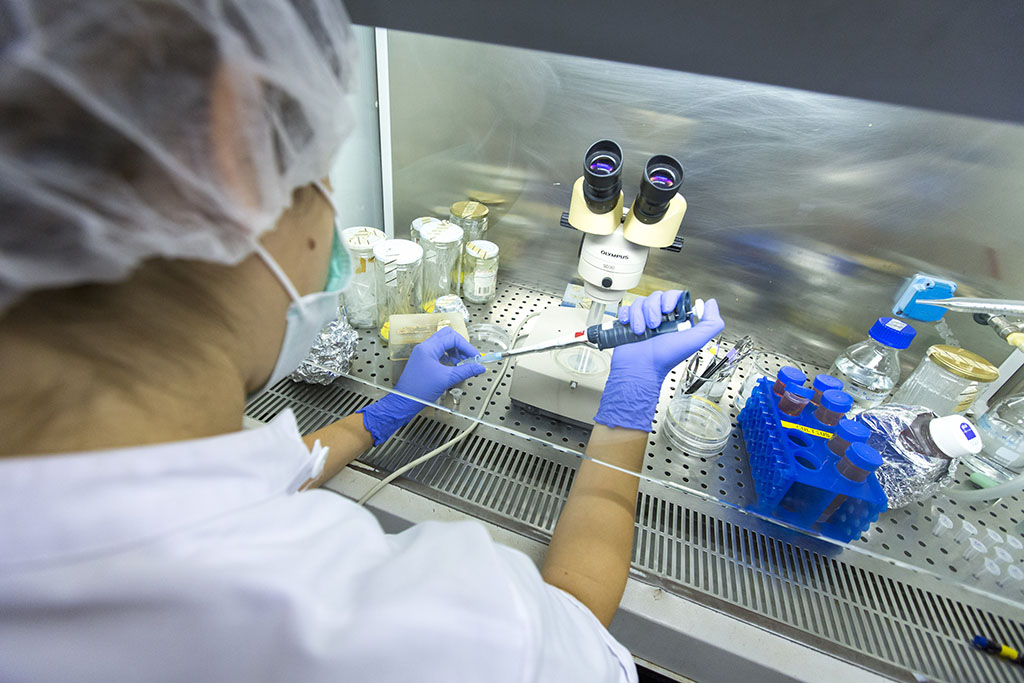Biomedical Sciences
History
The beginning of regulated medical education in Catalonia can be dated to the creation of a studium generale, the old name for a medieval university, in Lleida in the year 1300. Available data suggests that during the 14th century education was not always continuous, but from 1401 uninterrupted teaching was provided after King Martin founded the studia generalia of Medicine and the Arts. He had wanted to establish a comprehensive studium generale – equivalent to the concept of a modern university – but the Crown and authorities in Barcelona were unable to reach an agreement. The process was officially delayed until 1450, but in fact it was not until 1539 that an agreement was reached and the University of Barcelona was created.
The first teaching provided took place at the Hospital de la Santa Creu, which was founded around the same time by the combination of a number of smaller institutions that were struggling to survive. Continuous teaching was carried out there for over three centuries until 1717 when the University of Barcelona was closed down, along with all other Catalan universities, and a new university was established in Cervera. Despite the willingness to abolish existing services, medical studies continued in Barcelona, although the position was precarious because medical education was being carried out in a city that had no college and no association to Cervera. Not surprisingly, this arrangement lasted for a relatively short time. In 1760 new official studies of a high level were established with the creation of the Royal College of Surgeons, although medicine and surgery were quite different professions at that time. These studies were established largely due to the work of Pere Virgili, who was behind the creation of the first two Spanish surgery colleges, in Cadiz (1748) and Barcelona (1760). The creation of the Royal College of Surgeons in Barcelona was a response to a significant need for health services, a lack of surgeons, and the low level of medical training provided for doctors in academic universities.
At first the College was established within a hospital, but this created serious problems of coexistence and a few years later non-clinical studies were re-located to a separate building with a large anatomy room. This is the building that currently houses the Royal Academy of Medicine in Carrer del Carme in Barcelona. A few years later Virgili founded the Academy of Practical Medicine, and towards the end of the 18th century there was an attempt to unite the two disciplines in a ‘united faculty’. The Academy employed two teachers of clinical medicine, Francesc Salva Campillo and Vincent Mitjavila being the first to hold these positions, and from then on studies in medicine were once again available in Barcelona. In the intermediate period only surgery studies had been available in Barcelona, meaning that anyone wishing to become a doctor had to complete certain studies at the university in Cervera. The only alternative for aspiring doctors was to complete an entire course of studies outside Catalonia, normally in Huesca, Zaragoza, Valencia, Gandia or even in Toulouse and Montpellier.
The College of Surgery survived until 1843, at which point a revolutionary curriculum devised by Pere Mata led to deep reforms in the structure of medical education. The first part of his new plan was to abolish the teaching of medicine in Colleges of Surgery and all Spanish universities. The second part was to create faculties of Medical Sciences in Madrid and Barcelona, and several other schools of lower standing. Also, for the first time, a structured and coherent curriculum unique to all faculties was devised. After a short time some concessions were made, particularly regarding the geographic location of the faculties.
The Faculty of Medicine as it currently stands dates back to 1843, and as mentioned above it was effectively a regeneration of the College of Surgeons with some additional changes. It was located on the same premises and the majority of teachers were from the College, so having taught at the Royal College they became teachers of the Faculty of Medicine. Teachers from the College of Pharmacy also joined the Faculty of Medicine, although temporarily, as after two years they were again separated into an independent faculty. Some teaching staff from the College of Cadiz also arrived, as their facility had been closed down, but it was reopened following political pressure and these appointments only survived on paper. Two members of teaching staff from the College of Pamplona also joined the Faculty around this time.
In its first years of operation the Faculty was not particularly outstanding, as the general level of medicine was low, but the last third of the nineteenth century saw a great awakening in Catalan life. The clearest examples of this were economic growth, with the 1888 Exposition and the amalgamation of the villages of Barcelona, together with the rebirth of the Catalan language, and it was also a time when the area of medicine began to make advances. In the early 1870s, key positions at the Faculty were filled by a number of young teachers with particular drive, who came to be known as the ‘Catalan medical generation of ’88’, and they improved both the level and enthusiasm for teaching. Some young people, although few, continued to study in other parts of Europe, and medical journals noted a certain amount of internal criticism. One consequence of this momentum for change was a move from the small old building that had housed the Faculty to a new location in the Eixample district of Barcelona, which also included a new hospital. The struggle for a new faculty and hospital had taken almost thirty years from the initial presentation of the project until the inauguration of the new facility in 1906. The most significant teachers of this period were Joan Giné Partagas, perhaps the most remarkable; Bartomeu Robert, a great clinical medic and politician; and Santiago Ramon y Cajal, who taught there for less than five years (between 1887-1892) but who performed his life’s work at the Faculty, declaring that in 1888, ‘I reached my peak’.
By the time the new Faculty was to be opened all of the teachers that had driven the changes had moved on. And, in fact, another hospital was being built in an open field on the outskirts of the city, just on the border between the municipalities of Barcelona and Les Corts. As construction progressed the neighbouring villages grew, and soon the area was built up. The now vital force of Catalan medicine continued. A few years later, the original Hospital de la Santa Creu was also moved further from the centre of town to its current location as the Hospital de Sant Pau. Interestingly, at the time many people believed that the hospitals were too far away and nobody would go, so when the College opened its own hospital certain tensions were resolved. Some teachers achieved remarkable heights and of particular note was August Pi Sunyer, founder of the Institute of Physiology, which was actually the first operational Catalan medical service and had considerable impact on the scientific world of the day. Pere Nuviola created a notable Catalan school of obstetrics, following the path laid by gynaecological surgeon Miquel Fargas, and Francesc Ferrer Solervicens was also one of the more notable clinical teachers.
The 1930s brought a variety of basic changes to the Faculty. After the establishment of the Republic and Constitution in 1931, the Universitat Autònoma was founded in 1933. There were profound changes in structure, especially in the faculties of Medicine and Philosophy. The most significant was the incorporation of a large number of teachers who, whilst not registered teaching staff, were very skilled in medicine. In fact, the Faculty of Medicine secured the services of the chiefs of staff at Hospital de Sant Pau. Thus, the Faculty managed to nearly double its educational capacity, although the introduction of these changes did meet some resistance. Another measure was to limit the number of students, so the Faculty could provide more effective teaching, and students of the Faculty at that time tend to remember their experience in a very positive light. Again, the people motivating these changes were August Pi Sunyer and Jesus Bellido Golferichs from the Institute of Physiology, and the brothers Joaquim and Antoni Trias Pujol, teachers of surgery. They were all forced into exile in 1939.
After the Spanish Civil War there was a great change in mentality and the level of medical studies suffered considerably, but there were some very significant and persistent ongoing efforts. Perhaps the best example was the School of Clinical Medicine, directed by Agustí Pedro Pons, a teacher between the years 1927-1968 who also launched a periodical in 1943, Medicina Clínica, which continues to be published. He coordinated a remarkable treatise on medical pathology and facilitated the development of specialized clinics, as well as being a medical school principal.
The opening of other major Social Security hospitals and especially the creation of a second university in Barcelona with another medical school in 1968 signified changes in society to which the Faculty adapted with some difficulty, largely because they presented new problems. The most significant was overcrowding, as suddenly there were more than three thousand first-year students and around two thousand students on their last year. Teaching became less effective, but the situation inspired temporary solutions: collaboration with Bellvitge Hospital, which was a difficult process; the creation of medical studies in Lleida, Tarragona, and later in Reus; and limitations on the number of students. Also, for the first time on a wide scale, the stabilization of teaching staff was addressed and the teaching staff expanded, including professors and what would today be tenure-track and pre-tenured lecturers, as well as tenured teaching staff.
The Faculty then had to deal with two major issues: a new administrative structure that made many aspects of daily life more complex, and, more significantly, a run-down building that had been opened in that same century but was showing definite signs of age. This meant at least half the teaching staff and departments had to be relocated, which took far longer than initial forecasts predicted. Essentially that made further development at the time very difficult, and prevented the introduction of new ideas.
The original Faculty building was evacuated in 1984-85, and the Faculty was eventually able to move from its location in Pedralbes to the building in Carrer de Casanova in August 1996 (after initial construction work had been completed), which finally saw the reunification of the Faculty in 1996-97 after 13 years. The remodelled Faculty was officially inaugurated on 18 October 1996 in a ceremony presided over by the Minister of the Presidency of the Catalan Government, Xavier Trias Vidal de Llobatera, and which included a lecture by Colombian researcher Dr Manuel E. Patarroyo.
In the late 1980s, the Bellvitge Health Sciences Campus was created to house the new Faculty of Dentistry and the University School of Nursing. It was then that the Bellvitge-Medicine teaching unit was created.
In 1993, with the opening of the teaching unit of Sant Joan de Déu Paediatric Hospital in Esplugues de Llobregat, the Faculty added a teaching campus of the same name.
Finally, in 2016, the Faculty of Medicine and Health Sciences assumed its current structure when the Faculty of Medicine, the Faculty of Dentistry and the University School of Nursing were brought together in a single centre. This organization in three campuses that make up a single faculty enabled greater permeability between health-related courses, the joining up of projects and, ultimately, an overall improvement in teaching and research.




